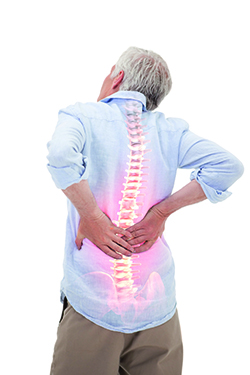Background
Osteoporosis (brittle bones) is one of the eight most common diseases in Denmark. It is estimated that up to 600,000 Danes have the disease and that 40% of all women and 15% of all men will get an osteoporosis-related bone fracture in the course of their lives. Osteoporosis is thus a costly disease to the Danish society amounting to 11.6 billion DKK in 2011. Especially fractures and the negative consequences of them make up for a large part of the costs. Approximately 10,000 hip fractures, 7,000 forearm fractures and 2,000 other fractures were registered in 2005, fractures that are primarily caused by osteoporosis. However, we also know that only 30-40% of all fractures come to clinical realisation, and they are, presumably, the most severe ones.
A fracture can occur when doing everyday things, such as reaching, twisting, lifting, stooping, coughing, and sneezing, due to changes in the bone mass and the micro-architecture of the bone caused by osteoporosis. The fracture can have major negative consequences for the patient due to loss of function. It can cause long-lasting, and even chronic, pain. Studies have shown that patients experience a clear decline in health-related quality of life and that this feeling remains after fracture healing. Besides, these patients have an increased risk of future fractures (both back and hip), and it is, therefore, very important that such bone fracture "cascades" are prevented, since progression (new fractures) is associated with increased morbidity and mortality.
Patients are currently treated according to different principles - from conservative treatments, to braces, and pain-relieving operations. A large proportion of patients stay at home in the acute phase, without further treatment, care and support. We know from clinical experience that patients often feel alone with the challenges caused by a fracture. The literature is extremely scarce, but a few foreign studies have described how women with bone fractures struggle to deal with everyday life tormented by pain, fear, decreased activity and changed self-image.
Mobile health technology has already proven to be an effective tool to support patients' self-care and action skills as well as communication and cooperation between patients and health professionals. Health-technology solutions targeted at osteoporosis are in their infancy. No one has implemented a telemedicine project specifically adapted to patients with bone fractures.
In this project, a mobile/virtual health-technology solution aimed at patients aged +60, who suffer from bone fractures, will be designed, developed, and tested. The process will be carried out in close collaboration with patients that have experienced bone fractures, GPs, healthcare specialists, nurses, and physiotherapists from the Osteoporosis Clinic at Odense University Hospital as well as Kolding Municipality's Healthcare Service, The Danish Osteoporosis Society, and the company MedWare.
Purpose/Vision
Based on the above, we want to implement a project that investigates whether mobile/virtual health technology constitutes a solution to patients suffering from fractures. Our prime focus is to improve the patients' empowerment and quality of life by applying a technology that can support the patients so that they can handle fractures both at the time of the occurrence and after, thus making the patients feel prepared and confident in terms of knowledge about osteoporosis/fractures, pain management, and physical activity/exercises. The technology must also support the patients' needs to talk to others in the same situation (knowledge sharing). Many feel alone in the period after the collapse, they are unsure of what a fracture means and how they should handle it. Several patients say that they do not speak with their doctor about, for instance, pain management. Often patients must learn the hard way, since knowledge on the subject is not readily available. Furthermore, there is rarely a clear answer to pain treatment and restrictions/guidance in connection with lifting. The vision is, therefore, to design and develop a mobile/virtual healthcare-technology solution that can enhance the patients' self-care and empowerment and thus increase their quality of life.
The project consists of three phases. The first phase aims to uncover the patients' needs and challenges in the periodervations, and literature studies on the subject. The identified needs will then form the basis for the second phase, in which different solutions will be designed and developed in order to meet the patients' needs. The best solution will be pilot tested and adjusted prior to the start of phase three, when the effect of the technology will be tested in a larger study. The vision is that the solution can be im after the occurrence. This will be done by means of qualitative interviews, obsplemented across sector levels, i.e. at the primary level (general practice and rehabilitation) and at hospital level through the "My Progress" project.
What is the expected outcome of the project?
The project will offer patients support in the period after the collapse, a support that only a few patients receive today. It may be support to pain management, physical activity, knowledge about osteoporosis and the changing body, such that the patients feel more equipped to take care of themselves, to prevent complications and new fractures. The vision is that the future health technology can improve the patients' self-care and functional capacity and thus their quality of life. It is expected that the future technology can be used across departments, hospitals and sectors, thus ensuring that knowledge is available to all patients. Furthermore, it is expected that the technology can be used generically, both broadly within the field of osteoporosis and in relation to other chronic diseases where self-care and functional capacity are key elements of a successful treatment, e.g. in terms of diabetes.